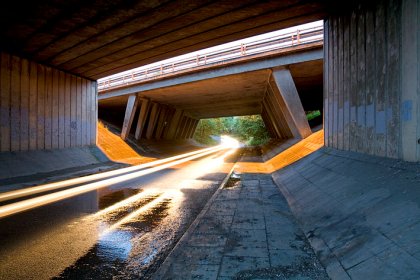M1 6A to 10 Widening |
|
Whole Project Award
Project Team:
Client: Highways Agency
Design: Atkins and Gifford
Construction: Balfour Beatty and Skanska (Joint Venture)
Employers Agent: WSP
|
The Project
The M1 is one of the busiest motorways in Britain and is a strategic link between London, the Midlands and the North. The section between Junctions 6A and 10 is approximately 10 miles (17 km) long, stretching from the M25 through to Luton. It was first opened in 1959 and carries over 160,000 vehicles per day with this figure set to increase to 200,000 by 2023.
The scheme to widen the motorway was developed due to the road suffering from frequent congestion and a poor accident record. In 2005 the Highways Agency awarded the £250m ECI contract to the Balfour Beatty Skanska joint venture with the design work to be carried out by Atkins and Gifford. The works were supervised by WSP as Employers Agent
Work commenced in mid March 2006 and was carried out on both carriageways to bring it up to a full standard four lane motorway with continuous hard shoulders. This was achieved by widening the following sections:
- Junctions 6A-7 southbound
- Junctions 8-9 northbound and southbound
- Junctions 9-10 southbound.
Other works included:
- Construction of new parallel roads between Junctions 7 and 8 to cater for local traffic travelling between Hemel Hempstead and St. Albans
- Widening or replacement of 11 underbridges on one or both carriageways
- Replacement of 7 overbridges
- Extensive public utility diversions, notably the overhead power cables at Junction 10 and near Redbourn.
The widened motorway was opened for traffic on 19 December 2008. During the development of the scheme the decision was taken by the client and contractor’s team to enter the project for a CEEQUAL Whole Project Award.
Landscape and Ecology
The scheme for the widening had originally been designed in the early 1990’s and included landtake for potential widening to 5 lanes in future and for environmental mitigation. During the design process the decision was taken to proceed with a 4 lane scheme which meant that larger areas were available for mitigation works. An extensive landscape scheme was developed, which included ground shaping and planting to restrict the adverse visual affects of the widening and to help blend in with the surrounding landscape. Over 200,000 plants were planted over three seasons.
A programme of ecological works was carried out, which included obtaining a licence for the relocation of a badger sett. The replacement sett has now been inhabited by the badgers. One of the underpasses on the scheme was used as a bat roost and for commuting bats. Low level lighting was installed to make the underpass suitable for continued use of bats and replacement roosts were installed in trees at either end of the structure. Large areas of species rich grassland were created on exposed chalk cutting faces along with other areas of wildflower grassland. A series of wildlife ponds were created along the length of the road.
Historic Environment
The M1 passes through an area of high heritage value and extensive archaeological investigation took place ahead of widening works which revealed a great deal of detail on Roman and earlier occupation of the area. The works were carefully designed to minimise further impact on The Aubreys, a Scheduled Monument from the late pre historic era which had been affected by the construction of the original M1 in the 1950’s. To recognise the M1 widening scheme as an example of 20th century cultural heritage a photographic study of the construction phase was commissioned to record the road as it was and the process of change.
Noise, Drainage and Community
The entire length of the road was covered in low noise surface to reduce noise impacts. Environmental barriers were installed to further mitigate noise impacts on local housing. The existing drainage system was upgraded to modern standards using SuDS principles with balancing ponds expanded to accommodate recent EA requirements for an increase in capacity of 20% for climate change. All the existing crossings over or under the road were maintained to ensure there was no increase in severance and improvements were made to make the scheme more suitable for use by equestrians and cyclists.
Material Use
The commitment to high standards of environmental performance was carried through to the construction of the project, including a focus on recycling and reducing waste. The project team’s strategy was to create a self-sufficient supply of aggregates close to the contract and avoiding the need to remove any unsuitable material from the project. This would minimise road lorry movements and distances travelled on the already heavily congested motorway and local road network and risk of delays. The key objectives of this strategy were to source aggregates and fills as locally as possible. This was in order to the contract to minimise delays to delivery vehicles caught in traffic congestion as a result of peak traffic flows and to minimise waste disposal by recycling and maximising re-use on site.
|
Key Materials Use Achievements
The key achievements of the scheme include:
- Dedicated off site recycling facility set up to facilitate the early supply of aggregates and act as back up throughout the duration of the contract.
- Establishment and set up of 3 on-site dedicated recycling centres to supply the bulk of the recycled aggregates required.
- In excess of 1,240,000 tonnes of recycled aggregates used – 92% of the total aggregates required for the project.
- 400,000 tonnes of high quality recycled aggregate used as Type 1 sub-base in lieu of primary aggregates.
- Re-design of landscape mounding / screening to accommodate in excess of 350,000 cubic metres of additional surplus earthworks materials.
- Use of recycled aggregates for drainage materials – 40% of the total used.
- Specific planning permission for a borrow pit to deliver a 100,000 cubic metres shortfall of suitable clay for fill material.
- Reduction in disposal to landfill – 1.07 million tonnes, based on re-using unsuitable earthworks and processing site arising hard waste into aggregates.
- Reduction in construction & demolition waste (C&DW) destined for landfill – 575,000 tonnes, based on quantity of C&DW imported and processed into aggregates on site.
- Reduction in lorry miles – 1 million miles, compared to imported primary aggregate from nearest rail head or nearest local primary aggregate sources and the export of unsuitable earthworks material to nearest inert disposal facility.
- Reduction in CO2 emissions – 1,715 tonnes CO2.
As a result of these initiatives the M1 Junction 6A-10 project was named National Champion of Commerce and Industry in the Chartered Institute of Waste Management (CIWM) section of the Green Apple Awards.



